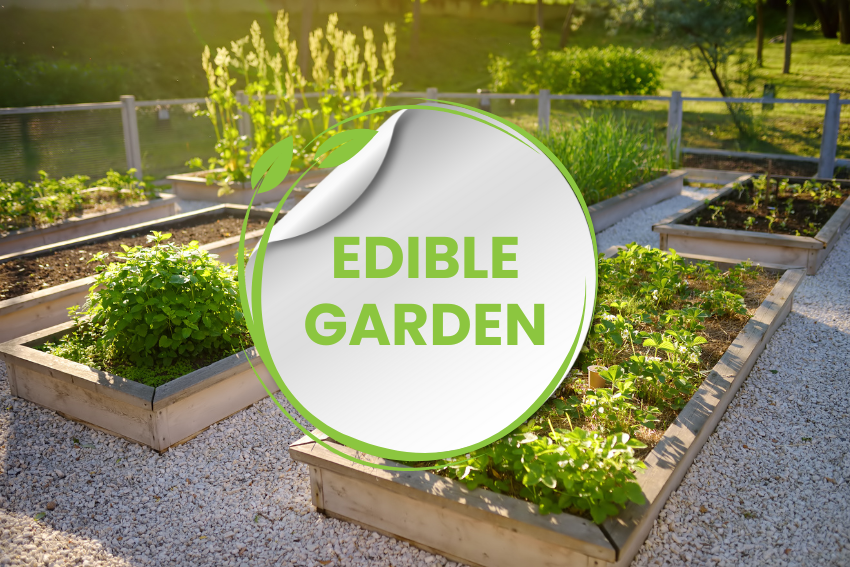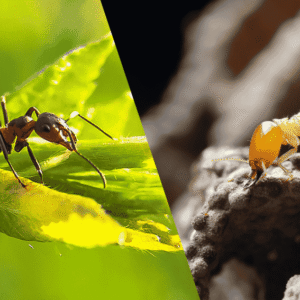The emergence of sustainability, self-sufficiency, and wellness as more than just terms has heralded the idea of growing one’s own food, quite literally, as an idea whose time has come. Regardless of whether you have an expansive swathe of land, a small backyard, or merely a sunny balcony, an edible garden is within reach. An edible garden can be a transformative experience that benefits you well beyond the contents of your plate.

Picture the exhilaration of picking fresh, crisp lettuce for your salad; harvesting ripe tomatoes from the vine; or snipping fresh basil for pizzas, from your own garden. Fresh, organic produce is most likely what launched your gardening idea, but growing provides so much more! It nurtures the soul, enhances mental health, and lowers your carbon footprint.
If you have been thinking of growing your edible garden and are concerned about the process, stop worrying! This thorough beginner’s guide covers everything you’ll want to know about the growing process: from your first plant selections to proud harvesting.
Why Grow an Edible Garden?
Let’s take a minute to appreciate why growing your own food may make growing your own food worth your time, effort, and love.
- Healthier Eating: Having access to your own veggies and fruits means you will find yourself eating fruits and vegetables (hopefully – you will find out how!). Gardening can help nurture cooking with nutritious ingredients and eating healthy snacks!
- Cost Savings: A packet of seeds can cost the same (or less) than one vegetable at the grocery store. Over time, that reduces your costs of food.
- Good for the planet: Buying locally grown food often means it travelled a minimal distance, and therefore a lower carbon footprint! Hand in hand with less travelling is less waste, specifically plastic packaging and food waste.
- Educational and therapeutic: Gardening is all about patience, respect, and love. It is also an excellent therapy session! Gardening is a natural way of reducing and gaining focus, practicing mindfulness and awareness, and getting back in touch with the natural world.
- Networking and sharing: If you grow too much food, congratulations! Availability, or being able to share your surplus with people in your community (if they are given the opportunity) is an enjoyable experience for both parties! You can share with neighbors, hold a food (swap) event, or donate to local shelters.
8 Steps to Growing an Edible Garden
Whether you’re a new or experienced gardener, use our simple yet comprehensive guide to learn what you need to make your own edible garden flourish.
Step 1: Planning Your Edible Garden
Every great garden begins with a design. This design will help you get started on laying the groundwork for your future bounty!
Know Your Space See what space you have to work with. Are you gardening in:
- A backyard plot?
- A small patio?
- A balcony or roof?
- A windowsill indoors?
The number one priority for growing edible crops is sun. Most vegetables require 6–8 hours of full light exposure daily, so pay attention to your area and where the light falls during the day.
Keep it Simple If you are building your first edible garden, start small, maybe a 4×4-foot area of raised bed frames, or a couple of pots. As your skills improve and you grow in confidence, you can expand your garden!
- Know Your Climate: The climate where you live, along with the USDA Hardiness Zone, will mean plenty of difference in which crops you can grow, and when. A planting calendar that is specific to your area, will help you plan your growing season.
- Design the Layout: Whether you are using raised beds, rows, or pots, you will want to think about their spacing, how much sun they will receive, and companion planting strategies. Place taller plants (like corn or tomatoes) at the north end to avoid shading smaller plants. Consider accessibility for watering, harvesting, and pest control.
- Sketch out a rough garden map: Visualizing the placement of each plant makes the process less overwhelming and ensures better productivity.
Step 2: Choosing What to Grow
There are some vegetables that do not lend themselves to being grown by beginners. Choose plants that are:
- Easy to grow
- Suitable for your climate
- Enjoyed by you and your family
- Quick turnaround to see results (for motivation!)
Top 10 Easy Crops for Beginners;
- Tomatoes – especially cherry tomatoes; yield so much good flavor.
- Lettuce – Quick growing, good for cut-and-come-again.
- Radishes – As little as 3-4 weeks for harvest.
- Carrots – Can be grown in containers or in the garden.
- Green Beans – Can grow on poles or bush varieties; easily done.
- Zuchini – Will produce a lot, and little to care for.
- Herbs (Basil, Mint, Parsley) – Great for containers or windows on kitchen sill.
- Peppers – Sweet or spicy; do well in warm climates.
- Spinach – Cools off, grows quickly.
- Strawberries – Sweet reward for your hard work; can grow in pots or hanging baskets.
Bonus Tip: Mix some perennials (herbs, strawberries) with your annuals to get continuing benefit from the initial planting effort.
Step 3: Selecting the Right Containers and Soil
In-Ground Containers are great for first-time gardeners or people with space restrictions. Containers are easy to control and move around.
Raised beds are better for drainage, pest and diseases, and soil quality. In-ground — gardens require more space but it is important to prepare the soil first.
Picking the Right Soil:
Don’t just use plain dirt. Plants will thrive in soil that can drain quickly while being rich in nutrients. Search for “vegetable garden mix” at your normal gardening center, or make your own mixture, exactly as it is done in the commercial mixes: 40% topsoil, 40% compost, and 20% either peat moss or coconut coir. Remember to add organic matter, such as compost and worm castings to your soil on a regular basis, to keep it fed and alive! Soil Testing You may want to get your soil tested for nutrients and pH level. Local extension offices may often provide soil testing. Most vegetables prefer a pH level of 6.0 – 7.0.
Step 4: Planting Your Garden
Seeds or Seedlings?
Seeds: More variety and less expensive, but they take more time and care.
Seedlings (Transplants): Easy for beginners; already germinated, faster to harvest.
Follow instructions on the seed packet or label about spacing and depth. Don’t plant too closely together since plants grow best with good airflow and sunlight.
Watering Tips
- Water early in the day to limit evaporation.
- Keep soil moist but not saturated.
- Mulch will retain moisture, creating less weeding.
- Drip irrigation systems and soaker hoses can make watering easy and keep excess water from being wasted.
Step 5: Tending to Your Garden
- Sunlight, Shade, and Heat; Even sun loving plants can be challenged in hot weather. In extremely hot climates, consider using shade cloth during the height of summer.
- Fertilizing: Fertilize your plants every couple of weeks with a complete organic fertilizer or compost tea. Too much fertilizing will cause lush, deep green growth with limited fruit set.
- Weeding and Mulching: Weeds compete with your plants for nutrients. Pull weeds regularly by hand and use mulch (straw or bark chips) to discourage weeds and to conserve moisture.
Pest Management the Natural Way:
Avoid chemical pesticides whenever possible. Use:
- Neem oil spray
- Companion crops (basil near tomatoes)
- Natural enemies (ladybugs, birds)
- Physical barriers (nets or row covers)
- Pruning and Staking: Do your best to support your plants. Support for tomatoes and beans should be supplied using cages or stakes. Remove damaged or excessive leaves to allow air movement and help prevent disease.
Step 6: Harvesting and Storing Your Produce
When to Harvest
- Lettuce and Spinach: Take leaves once they are big enough to eat.
- Tomatoes and Peppers: Harvest once they have full color and feel just a little soft.
- Zucchini: Harvest the vegetable while it is still young and tender 6-8 inches in length.
- Root Vegetables (such as carrots and radishes): Check the top of the root that is above the soil.
How to Store Fresh Produce
- Leafy Greens: Place in the fridge wrapped in a wet paper towel.
- Tomatoes: Store at room temperature.
- Herbs: Freeze in ice cube trays with olive oil, or dry for tea or seasoning.
- Beans and peas: Blanch and freeze for long-term storage.
Step 7: Composting – Turning Waste into Gold
What Can Be Composted?
- Greens: vegetable scraps, coffee grounds, grass clippings.
- Browns: Leaves, recycled cardboard, shredded newspapers. Do not add meat, dairy or greasy food. Turn your compost heap regularly to speed up decomposition. In a few months, you will have rich, dark compost to add to the soil to increase its fertility.
- Vermicomposting: Short of Space? Vermicomposting with red wiggler worms is an excellent option indoors and provides valuable nutrient-rich worm castings.
Step 8: Seasonal Care and Crop Rotation
Avoid growing the same crops in the same place every year. Follow crop rotation to sustain soil nutrients and mitigate pest problems.
- Spring: Most of these crops will be cool-season crops where the soil can be warm and moist: lettuce, peas, spinach.
- Summer: Warm season loves: tomatoes, peppers, eggplant.
- Fall: Root vegetables, kale, arugula.
- Winter: Garlic, overwintering onions, cover crops. Use the off-seasons to rest the soil with green manure or mulch.
Developing A Year-Round Growing Plan
It is possible to have fresh produce most of the year, with a little planning. Extend your growing season by using cold frames, mini hoop houses, or indoor grow lights.
Frugal Gardening Tips
- Seed swaps and local garden groups are a great place to start.
- Containers can be reused like yogurt cups, and milk jugs.
- Compost your own food waste, and make organic fertilizer.
- Collect rainwater with barrels to water your plants with.
- Create your own inexpensive garden markers with repurposed materials, such as wooden spoons or painted rocks and stones.
Troubleshooting Common Issues
- Yellowing leaves usually due to overwatering, unmanageable draining issues, or lack of nitrogen.
- No Fruit on Healthy plants may be blamed, sometimes, on too much nitrogen, lack of pollination, or watering issues.
- Wilting plant created by possible heat stress situations, disease, or root rot from overwatering.
The best tool is observing; spend time in your garden, check every day, and respond accordingly.
Diseases to watch for;
- Powdery Mildew
- Blight
- Leaf Spot
- Root Rot
As much as possible, use disease resistant varieties and practice good crop hygiene.
The Joy of Gardening Beyond the Plate
Your food garden is more than where you get food from. It’s a dynamic experience, something alive that you can simply enjoy, educate yourself on, and even connect with your loved ones. Growing food can allow children to be curious and ask questions, whether it’s experiencing how much bigger a seed grows, or perhaps where their food comes from! You can add even more complexity to your garden with flowers that attract pollinators, vertical trellises, companion plants, etc. Hopefully, these suggestions allow you to have a richer and more productive ecosystem in your space.
Creative Additions to Your Garden:
- Make a sensory garden with herbs such as lavender or mint.
- Create a DIY salad bar planter with lettuce, radish, and chives.
- Paint your pots and containers for a more cheerful space!
Conclusion: Sow Today, Reap Tomorrow
It may seem small when you begin an edible garden, but what you are doing runs deeper. You are growing more than food. You are growing confidence, sustainability, and happiness. You will learn to understand the ebb and flow of the seasons, the patience involved in encouraging life, and the remarkable taste of food grown by your very own hands.
So, pick up your trowel, choose your first couple of seeds, and get started. Your harvest is waiting.






